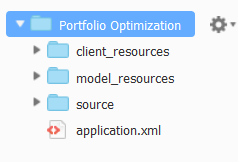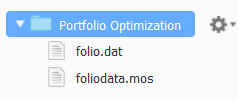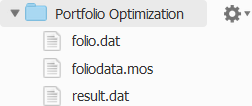At this stage, you can run the model via the Mosel command line or from Xpress Workbench. This guide follows a workflow that uses the facilities provided by the browser-based variant of Xpress Workbench and (later) its close integration with Xpress Insight.
Before trying to run anything, ensure that you have prepared two files:
- foliodata.mos - the model source file as described earlier.
- folio.dat - the separate data file containing values for the RET, RISK and NA entities, and implicitly the SHARES entity—again as described earlier.
To load and run the model within
Xpress Workbench:
- Visit the Xpress Workbench URL and log in.
- In the Xpress Workbench HOME page, click CREATE PROJECT, enter a value of Portfolio Optimization in the Name field in the subsequent Create Project dialog and then click SAVE.
A new tile called
Portfolio Optimization appears in the Xpress Workbench
HOME page.
|
|
Note Depending upon your installation, you may see an existing project tile labeled
Portfolio - An Optimization Model Example on the
Xpress Workbench
HOME page. This is a more advanced portfolio optimization model provided as an example, and is unrelated to the new
Portfolio Optimization project just created.
|
- Click on the Portfolio Optimization tile.
Xpress Workbench launches your new project in which it has created a template application structure. Examine the contents of the vertical Project tab:

A New Xpress Workbench Project
This arrangement of new files and folders is designed to help you start quickly with a new
Xpress Insight app.
- However, for this first walk-through, we are going to start from scratch, so right-click on the following resources, choose Delete, and confirm:
- client_resources - folder
- model_resources - folder
- source - folder
- application.xml - file
You are left with a single empty Portfolio Optimization root directory.
- In the File menu, choose Upload Local Files and follow the prompts to upload your prepared files - foliodata.mos and folio.dat - to the Portfolio Optimization root folder.
The project structure now appears as:

Uploaded Model Source and Data Files
- In the Run menu, choose Run foliodata.mos and wait a few moments.
The model compiles and runs, and a new file appears in the project tab, which now appears as:

Project Contents After First Model Run
The new file is
result.dat, the output file written by the model, originally declared as a parameter in line 8.
|
|
Note Depending on the settings of your
Xpress Workbench environment, some other files may also appear at this stage. For the purposes of this tutorial, they can safely be ignored.
|
- Review the contents of result.dat.
It contains:
Total return: 14.0667
treasury : 30.00%
hardware : 0.00%
theater : 20.00%
telecom : 0.00%
brewery : 6.67%
highways : 30.00%
cars : 0.00%
bank : 0.00%
software : 13.33%
electronics : 0.00%
This reveals that the maximum achievable ROI is 14.0667, and that based on the model's constraints, the optimum division of investment capital among share types is 30% to treasury, 20% to theater, 6.67% to brewery, 30% to highways and 13.33% to software.
The model has been run in its native form as a Mosel model, albeit called and executed by Xpress Workbench.
© 2001-2019 Fair Isaac Corporation. All rights reserved. This documentation is the
property of Fair Isaac Corporation (“FICO”). Receipt or possession of this documentation does not
convey rights to disclose, reproduce, make derivative works, use, or allow others to use it except
solely for internal evaluation purposes to determine whether to purchase a license to the software
described in this documentation, or as otherwise set forth in a written software license agreement
between you and FICO (or a FICO affiliate). Use of this documentation and the software described in
it must conform strictly to the foregoing permitted uses, and no other use is permitted.





